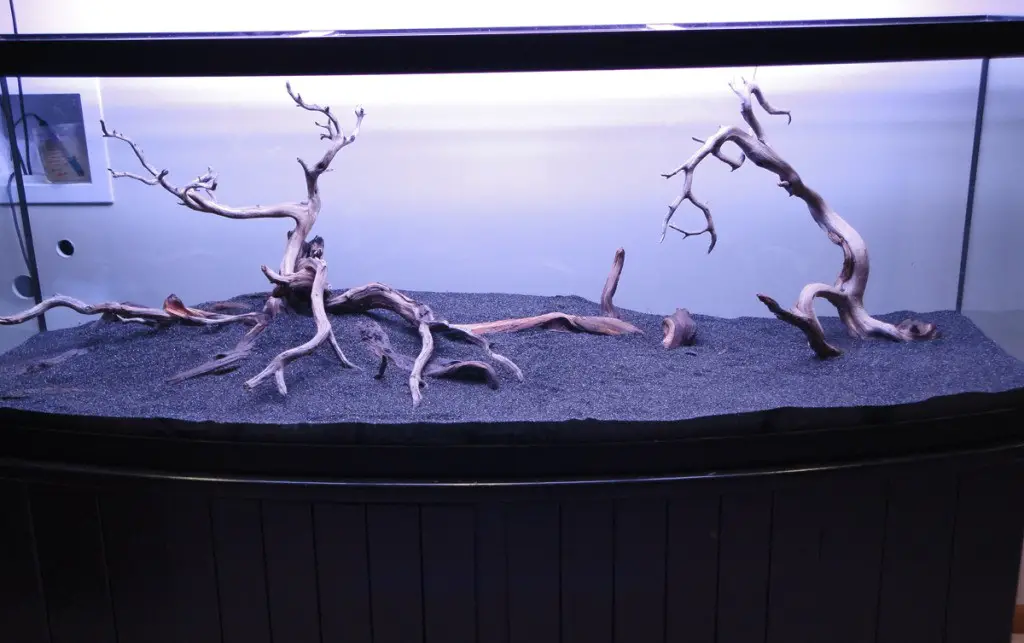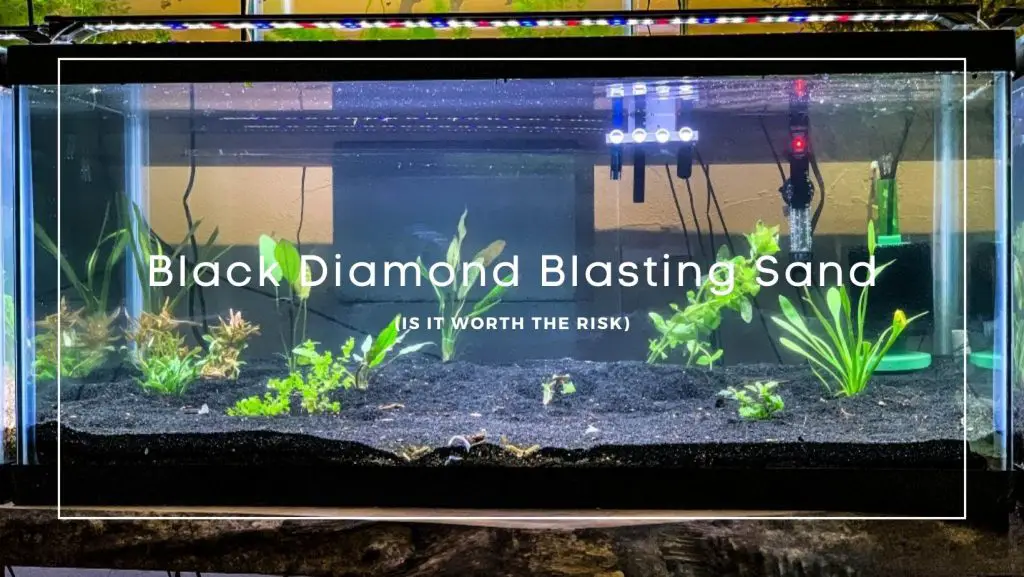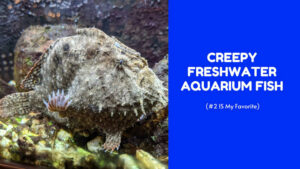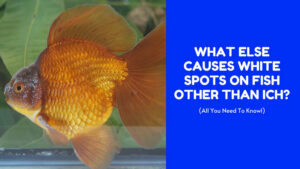Fishkeepers can agree that aquarium substrates can get a tad bit expensive.
And for the price you pay, you get a meager amount of gravel/sand. Add to that the fear of water parameter swings or toxic chemicals being imparted into the fish tank.
You must also be careful about the weight and size because heavier gravel can hurt your bottom feeders, and very fine particles may lend a cloudy look to the aquarium.
Enter Black Diamond Blasting Sand, an affordable, safe, and aesthetically pleasing alternative to the typical aquarium substrate. Let’s see how it is the best substrate for a fish keeper on a budget!
What Is Black Diamond Blasting Sand, And What Is It Made Of?
Black Diamond Blasting Sand (BDBS) is the recycled version of coal slag or boiler slag, primarily used in sandblasting projects. However, since it contains less than 0.1% free silicates, BDBS can double up as an affordable aquarium substrate.
Is Black Diamond Blasting Sand Safe?
Despite its abrasive nature that makes it suitable for sandblasting, BDBS is completely safe for your fish friends!
The coal slag does not contain any toxic substances, making it chemically inert. So, rest assured that using BDBS will neither cause water parameter swings nor harm your fish.
If you are concerned about the sharpness, BDBS is just as hard and coarse as any other sand out there. So, even sensitive fish like corydoras or freshwater eels that like hiding beneath the substrate can survive and thrive in an aquarium lined with BDBS.
And if that doesn’t convince you- tons of experienced fish keepers and hobbyists have been using BDBS in various types of fish tanks. So, it is no secret that it is a tried and tested alternative for the oh-so-expensive aquarium substrate!
What Are The Pros Of Using Black Blasting Sand?

BDBS is typically made of coal, which is “fired” at extremely high temperatures. The coal slag is then cooled down and allowed to solidify. So, naturally, BDBS is predominantly black in color.
However, it is not completely black! More about that in the later sections…
Affordable
If you’ve been fishkeeping for some time now, you must have realized that commercial aquarium substrates are expensive. However, you can get your hands on a 50 lb bag of BDBS for $8-10. Although the price may vary according to the outlet, it still provides a lot more value for money.
And while there are cheaper substitutes on the market, if you’re looking for the aesthetically pleasing black color, nothing beats BDBS.
Chemically stable
This blasting sand does not contain any more than 0.1% of free crystalline silica, making it chemically inert. The brand Black Diamond, specifically, does not mix any chemicals in the substrate. Plus, it is low dusting and marginally water-soluble, so it is completely safe for your fish buddies.
Aesthetic
Admit it- nothing looks better than a black backdrop for your colorful fishes to play around with. Additionally, BDBS boasts a shining texture, so it earns brownie points in the looks department!
However, you should note that BDBS is not entirely black. If you look closely, the substrate is actually rust-like, which may not be everyone’s cup of tea. On the other hand, most fishkeepers agree that the color difference is not noticeable, and either way, BDBS manages to look stunning in an aquarium.
Versatile
BDBS is available in various textures, so you can definitely find something that would suit your fishkeeping requirements. Most fishkeepers opt for the 20-40 medium grit as it settles on the bottom and looks like regular sand.
If you want something finer, check out the 30-60 fine grit BDBS. However, if you’ve got large fish in the tank, this variant may end up clouding the tank.
Also, anything finer than that, like the 40-80 ultra-fine grit, is a major no-no as it floats in the water column, making it dusty and difficult to vacuum.
No Diatom Blooms
A diatom bloom is the most common occurrence that fishkeepers have experienced when getting a new tank or after a major water/substrate change.
But thanks to the 0.1% of free silica in the formula, there have been no reported instances of diatom blooms caused by BDBS. Notably, many hobbyists have even tackled this so-called “new tank syndrome” by opting for BDBS as the new aquarium substrate.
What Are The Cons To Using Black Blasting Sand?
Difficult To Create A Slope For High-inclined Aquascapes
If you wish to create steep structures out of the substrate, BDBS may not be an ideal pick as it tends to shift and slide. However, you can DIY your way through this by using a hardscape to stiffen the BDBS structure. Or, you can use a different substrate underneath BDBS to secure the layer.
Risk Of Anaerobic Pocket Build-up
Although the possibility of anaerobic pocket build-ups is rare, BDBS is not immune to the risk. However, you can avoid this situation by steering clear of finer grit BDBS.
Or, you can add trumpet snails to the tank. And in case you’re wondering, BDBS is 100% safe for snails.
Difficult To Gravel Vacuum
Vacuuming any type of sand is a Herculean task, and BDBS is no different. But there shouldn’t be an issue if you use the medium grit variant.
Also, we suggest vacuuming BDBS by holding the siphon at an angle and kinking the attached hose before releasing it between suctions. This action will ensure that the residue is vacuumed efficiently while the sand remains put.
BDBS Is Not The Best Option For A Planted Aquarium
When it comes to the physical aspect, BDBS is quite dense and will ensure a stable grip on the plant roots. However, the substrate contains no nutrients for the plants, so you must supplement it with fertilizers or nutrient tabs. Note that a single tab lasts for months, so adding one regularly shouldn’t be a hassle.
Moreover, you can use your regular soil substrate and top it off with BDBS for heavily planted aquariums.
How To Prep Black Diamond Blasting Sand For An Aquarium?
Rinse It Well
Albeit not a necessity, BDBS must be rinsed thoroughly to remove oil and dust particles. Despite being chemically inert, such residue can form a dirty look in the tank.
Interestingly, both oil and dirt stuck on BDBS are not harmful to your fish, but we still recommend washing it for a clean-looking fish tank. You can use hot water to remove the oil completely, but never use soap as it can be toxic.
Alternatively, you can start with hot water soak for 1-2 hours and then rinse BDBS. Make sure that you use enough buckets for a thorough rinse, and perform this process outdoors. This is because the silt that gets washed off can settle in your plumbing fixtures, causing major issues in the future.
Further, it is best to do this process while wearing gloves as the gravel may get into your fingernails, or the residue may harm your skin.
Run A Magnet
There have been a few reports about BDBS containing small pieces of metal and glass. So, once you’re done rinsing, run a magnet through the sand to make sure that none of the aforementioned particles make their way into your fish tank.
Overall, be very careful while cleaning BDBS if you don’t want your fish to end up with tiny hurt bellies!
Where To Buy Black Diamond Blasting Sand?
BDBS is easily available in brick and mortar stores like the Tractor Supply Company or Amazon. Here, you can get your hands on sacks of BDBS at very competitive rates. Alternatively, you can visit hardware stores like Home Depot, but the product can cost higher (five times more, to be precise).
Note that you can get BDBS at affordable rates only if you visit the physical store. If you don’t live in the USA, you’ll have to opt for online shopping, which consists of expensive shipping charges.
Furthermore, if you’re unable to find the abrasive sand by Black Diamond, you can try looking for Black Beauty. It works just as well and is completely safe to be used in a fish tank.
Final Thoughts
Clearly, the pros of using BDBS outweigh the minor cons, which more or less depending on the user’s preferences and requirements. So, overall, BDBS remains an affordable, versatile, and chemically safe aquarium substrate for many fish keepers who have access to the aforementioned stores.
Alternatively, you can experiment with abrasive sand from other outlets because regardless of the brand, this substrate substitute is a must-have for any fishkeeper.
On that note, we’ll be signing off now. Let us know in the comments below if you’ll be using BDBS, or share your experience if used before. We’ll be back with more interesting guides soon, so stay tuned.
Until next time, happy fishkeeping!





